Is it Plantar Fasciitis or is it Plantar Fasiosis?
Plantar Fasciitis: Inflamation of the Plantar Fascia.
Plantar Fasiosis: Micro-tears, Scar/dead tissue of the Plantar Fascia.
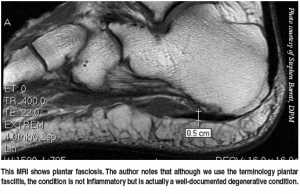
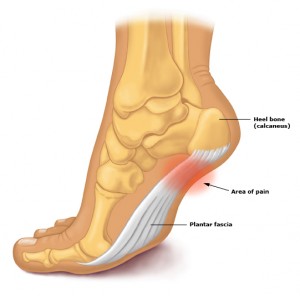
The jury is still out but what is 100% crystal clear is the pain and suffering this condition brings to those that have it. A constant pain that at times has you thinking that it really is a death by a thousand footsteps. From the moment you take those first tentative steps of getting out of bed in a morning to the last steps of getting back into bed at night your whole world is filled with a pain that is easy to describe, stabbing, walking on glass, tearing, yet hard for non sufferers to truly understand until they are unfortunate enough to find out for themselves first hand as what happened to myself this year.
I’d heard about Plantar Fasciitis and that is was a condition of the feet that left the sufferers in discomfort but my knowledge went only as far as that. I’d been suffering with sore feet most mornings for the past 12 months but had put it down to my job because it only seemed to be an issue the day after very heavy workloads and being on my feet for extended periods of time. Eventually the sore feet on a morning changed to incredible sore foot all day everyday to the point of virtually being housebound for days on end.
Initial Diagnosis
The Doctors diagnosis was Plantar Fasciitis with what would seem the routine prescription of anti-inflammatory drugs, put inserts into your shoes and rest the foot.
What follows is a culmination of months of reading, researching and trial and error into one condensed, easy to read guide. I hope.
See your Doctor as soon as possible to get a full diagnosis. If possible ask them to book you an appointment to see a Musculoskeletal (MSK) Practitioner and a Physiotherapist. The MSK will give you a thorough examination and use ultrasound to determine the extent of the damage in your foot and then give you the option of a Cortisone injection if needed.
Cortisone injections
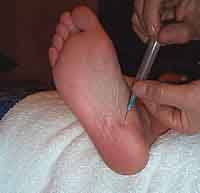
Cortisone injection, a scary thought if you go by a lot of what you see on the internet. There are a lot of horror stories on the internet about the use of Cortisone in treating Plantar Fasciitis. After my own discussions with the MSK Practitioner I was left thinking that those that suffered issues probably had too many injections, didn’t have the injection in the correct place or didn’t follow the after care advice to the letter that they would have been given after the injection. I’d read all the horror stories myself and was apprehensive about getting it done to the point that when it was advised that I have the injection I turned it down. It was only whilst putting my shoes back on and spending a few moments calming down and controlling my thoughts and fears from everything I’d read did I then decide I needed to get this done. Let’s face it if it was such a bad practise it would have been removed from normal practise of treating the condition. What followed was a few minutes of abject terror as I laid there sweating like a smack head with the keys to a pharmacy. In went the local anaesthetic then a few minutes later the Cortisone injection was done guided by the ultrasound so it went exactly where it was needed most. Nearly pain free other than feeling the initial breaking of the skin as the local anaesthetic went in.
As it was explained to me the use of the Cortisone is to breakdown all the scar and dead tissue in the foot and around the Plantar Fascia so that the body can then begin laying down new healthy tissue in its place. Once you have had the injection it’s recommended that you spend as little time on your feet as possible for the next 24-36 hours so that the Cortisone stays where it has been injected and begin its job of breaking down what should not be there. I have to wonder if those that seem to get little or no benefit from the injection are not following Doctors orders and are on their feet rather than resting up. Another reason against Cortisone is the rupturing of the Plantar Fascia itself through too many injections. From speaking with the Musculoskeletal Practitioner it is advised that you receive no more than 2 injections in a six month period otherwise you then run the risk of damaging the Plantar Fascia and possible rupture. What I can say is that I did exactly as I was told and within three days started to see a reduction in the overall swelling.
Stretching
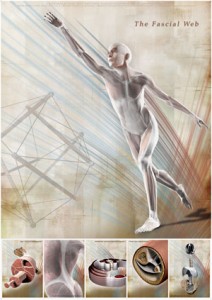
I was then prescribed stretches to do 3 times per day for the calf muscles along with rolling the foot over a foot massager or golf ball to aid the breaking up of scar/dead tissue. After the follow up appointment a further stretch was added for the Plantar Fascia itself.
There are various forms of stretching that you can do for the foot, calf and surrounding areas to help alleviate the tension on the Plantar Fascia. I was prescribed passive stretching whilst I found a contract relax style worked much better for me.
Passive stretching: Holding a stretched position for 30 – 60 seconds
Contract relax stretching: Holding a stretched/contracted position for 10 seconds with a 5 second release before repeating again for a further 2-3 rounds.
Not only look at stretching the usual suspects but also look at whether you have tension in your hamstrings, gluteus muscles and even your back. Tightness in all these areas will alter your bio-mechanics and the way you walk which in turn places greater stress on the Plantar Fascia leading to inflammation and the build up of tension, trigger points and scar tissue. The freer you are the freer your feet will be but remember it also works the other way around as tension builds in your feet it then travels up the body affecting everything else up that chain. So try to keep those feet loose and able to do their job so that excessive tension isn’t allowed to build up through the Plantar Fascia.
Insoles, Orthotics and Footwear
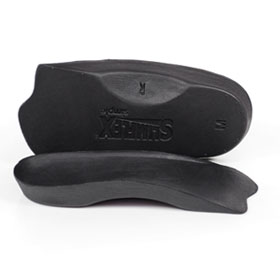
Earlier I mentioned the use of insoles in treating the condition. Yet another bone of contention on the internet as to their effectiveness. What I can say from my own experiences is that they are needed in the initial stages of getting the condition under control and bring you a reduction in pain so that you can start to move around again. I can fully understand the opinion of those that say not to use them as they weaken the foots muscles and possibly make things worse. My thoughts are pretty simple. Use them to get relief and start healing. Once the condition is fully healed then consider not using them for periods of time to rebuild the strength back into your feet till you get to a point were you may no longer need to wear them. But only you can decide that.
I tried three pairs. One pair didn’t work and they’re still here in the box. The other two worked for a while then one pair stopped being of use. So now I have just one pair which I find have a high enough support in the arch that allows a good drop in the heel so the heel can sit in the orthotics and my shoes without having excessive pressure place on it or the Plantar Fascia hindering my recovery. These I wear everyday in a variety of different footwear. One thing I did find was that as the swelling subsided in the foot either during the day or as weeks went by I needed to have multiple pairs of footwear around to compensate for that. Sounds bizarre I know but true. I even use the orthotics in what are termed barefoot shoes, shoes designed to have minimal sole allowing the muscles of your feet to become stronger and move as nature intended. What I found with these shoes was that they have a large toe box that lets my feet spread so they are not crammed into a tight space and squashed out of shape. This works for me as I can still work the feet a little to strengthen them at the front but at the same time protect the heel through the orthotics. Another pair of footwear I have found to be of benefit to me was the Nike Free trainers. A trainer again designed to mimic natural foot movement mechanics through the use of an innovative sole. They are unbelievably soft and comfy and again allow me to gently work the muscles of the feet whilst being cushioned enough to not stress the Plantar Fascia and heel pain. Unsure if I would ever run in them as designed but as a casual trainer for getting around in with Plantar Fasciitis they do work.
Trigger points
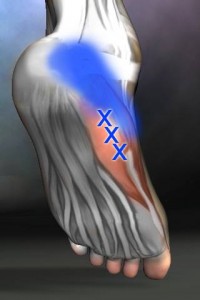
Trigger points are basically points within a muscle that become glued or knotted up which then add to the muscle and surrounding area(s) not being able to move as freely. I found a lot in my calf muscles a very common area to get them. These will also be present in your foot and you will notice them as you do your foot rolling as sore and somewhat painful points which have to be released if you are going to achieve full recovery. Some people use foam rollers or my own favourite is a company called TP Therapy who sell a variety of devices for different jobs and parts of the body. Be warned working those tender areas can be extremely painful but also be wary of not getting too carried away and doing more damage than good.
Strengthening
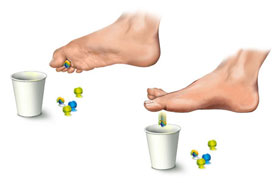
So your working your trigger points and stretching yourself out on a daily basis now you need to look at a strengthening program. Strengthening not only the feet but also your hip and core regions. The feet part I would suggest not starting on until your feet are pretty much healed or fully healed. You don’t want to make the condition worse or undo any of your hard work done in other areas. But when the time is right there are plenty of exercises out there that you can find just be sure to start off very gently not only in how much you do but how hard you do the exercises and remember to not just work the soles of your feet but also the tops of your feet through toe spreading and lifting type exercises. From there you can then start to look at your calf’s and balance. Yes balance which you can do through walking on your tiptoes or just balancing on one leg at a time in bare feet and building up to doing it with eyes shut. That one will test you.
Up till that point I would suggest working on strengthening your core and hip muscles through Pilates. I’ve found it of great benefit and its shown me a thing or two about how weak you can be in certain areas yet not even know it because you’re massively overcompensating in others which the body will automatically do just to keep you going. Nothing more humbling than watching a lady far older than yourself moving with ease through all the exercises whilst your busting a gut and sweating buckets on the level 1 positions. As you become stronger with the Pilates and looser from the stretching you’ll notice that the way you move and walk will alter quite dramatically and so will your energy levels especially as you start to release the tension in your spine and surrounding musculature. A win win situation.
Steven A Barlow, Co founder www.spartan-warriors.co.uk and founder of Spartan Runners “because we don’t just run” © 2013







